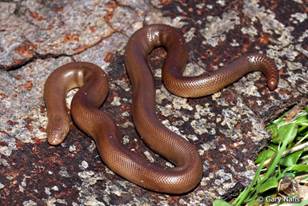Southern Rubber Boa (Charina bottae umbractica)

The rubber boa is smooth and shiny. Uniformly olive-green, reddish-brown, or tan to chocolate-brown. The scales are smooth, in 32-53 rows. Large scales are on top of its head. Adult grow to over thirty inches. The average is from 14-33 inches long. The short broad head and tail give it a two-headed look and the eyes small, so one must look twice to see which end is which.
The Southern rubber boa is a subspecies of the latter is found only in coniferous riparian forests in the San Bernardino and San Jacinto mountains. Its habitat is damp woodland and coniferous forest, large grassy areas meadows, and moist sandy areas along rock streams from sea level to 9,200 feet. It lives in burrows below ground most of the time, and because it is so retiring and seldom seen, very little is known about it. It hibernates in rock outcrops, rotting stumps, or other below-surface retreats until April or May.
The rubber boa is live-bearing; 2 to 8 young, 7 inch long are born late August or September. The rubber boa is crepuscular and nocturnal. An accomplished burrower, it retreats under rocks or into damp sand, hollow rotting logs, or forest litter. Also, it is a good swimmer and climber; its prehensile tail enables it to climb shrubs and small trees. A constrictor, it preys on small mammals, birds and lizards. It is docile and curls into a ball when picked up. Captive longevity exceeds 11 years.
Since 1971, the Southern rubber boa has been listed as one of California’s threatened species. Habitat loss is the principal cause of this species’ decline. The principal causes of habitat loss include resort development, OHV activities, logging, and wood gathering.